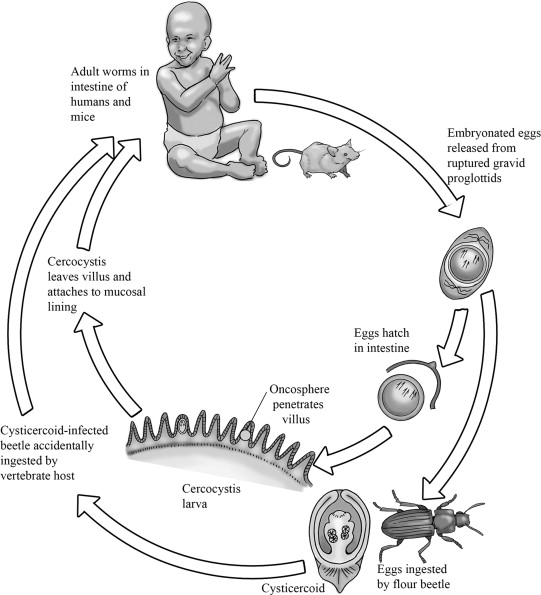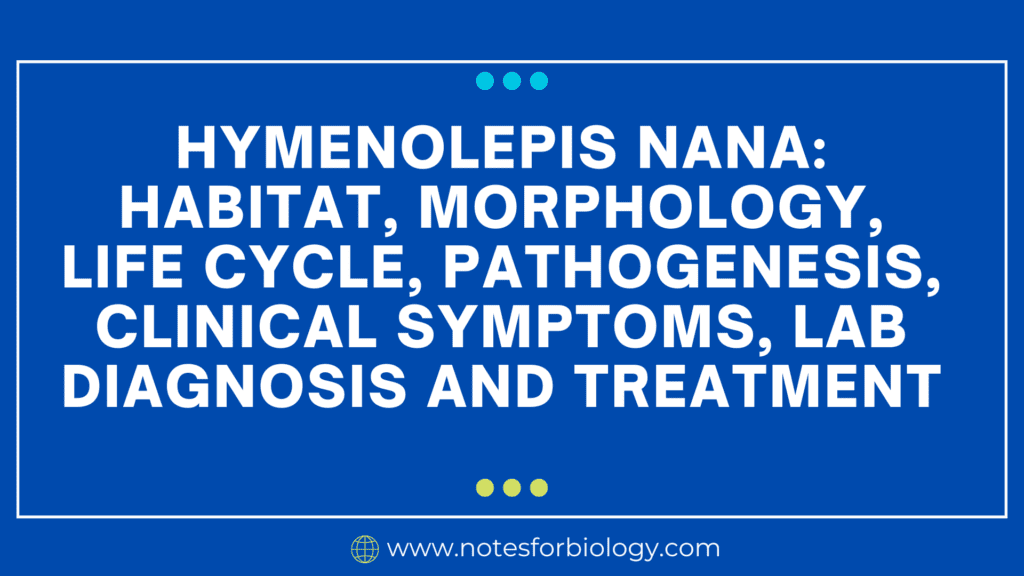Hymenolepis nana, commonly known as the dwarf tapeworm, is a small parasitic worm that often infects humans, especially children. This tapeworm is unique because it can complete its entire life cycle within one host, making it easy for the parasite to spread and persist in infected individuals.

Table of Contents
Habitat
Hymenolepis nana primarily resides in the small intestine of humans and rodents, where it attaches to the intestinal lining to absorb nutrients. Infections are common in areas with inadequate sanitation, especially in tropical and subtropical regions. Children are more frequently infected due to closer contact with contaminated environments.
Morphology
Hymenolepis nana is called the “dwarf tapeworm” because of its small size, ranging from 15 to 40 mm in length. It has a head, or scolex, equipped with four suckers and a rostellum (a small hook-like structure) that helps the worm anchor itself to the intestinal wall. The body is made up of a series of segments called proglottids, each containing both male and female reproductive organs, enabling the worm to reproduce on its own.
Life Cycle

The life cycle of Hymenolepis nana can be completed entirely within a single host or involve an intermediate host, such as insects like fleas or beetles. The basic stages include:
Ingestion of Eggs: Humans or rodents become infected by swallowing the eggs, which can be found in contaminated food, water, or on hands.
Larvae Hatch: Inside the host’s intestine, the eggs hatch, releasing larvae known as oncospheres, which penetrate the intestinal wall and develop into cysticercoid larvae.
Maturation: The cysticercoid larvae return to the intestinal lumen, where they mature into adult tapeworms that produce eggs. These eggs are then passed in the host’s feces, ready to infect others or reinfect the same host through autoinfection.
Autoinfection: Eggs can hatch within the host’s intestines and restart the cycle, leading to persistent infections without the parasite needing to leave the body.
Pathogenesis
The harm caused by Hymenolepis nana is primarily due to its attachment to the intestinal lining, where it interferes with nutrient absorption and causes inflammation. When the infection is severe, the large number of worms can crowd the small intestine, worsening symptoms.
Clinical Symptoms
Symptoms of a Hymenolepis nana infection depend on the number of worms present. Many people with mild infections experience no symptoms. However, when symptoms do occur, they may include:
Digestive Issues
- Abdominal pain or cramps
- Diarrhea
- Nausea or vomiting
- Appetite loss or weight loss
General Symptoms
- Fatigue or weakness
- Irritability, especially in children
- Itching around the anus
- In more serious cases, especially in children with heavy infections, the parasite can lead to malnutrition, dehydration, and stunted growth.
Lab Diagnosis
To diagnose a Hymenolepis nana infection, stool samples are examined under a microscope to detect the parasite’s eggs. These eggs are easily identifiable due to their distinct polar filaments. Since the eggs may not always be present in every sample, multiple samples may be necessary to confirm the diagnosis.

Treatment
Hymenolepis nana infections are treated with antiparasitic medications. The most commonly prescribed drugs are:
Praziquantel: This is the preferred medication for treating dwarf tapeworm infections. It works by paralyzing the tapeworm, causing it to detach from the intestinal wall and be expelled from the body.
Niclosamide: Another effective drug, which kills the tapeworm and aids in its elimination from the body.
Both medications are generally safe and effective, though repeated treatment may be required in cases of autoinfection or reinfection.
Prevention
Preventing Hymenolepis nana infections primarily revolves around improving hygiene and sanitation practices, especially in regions where the tapeworm is common. Key prevention methods include:
Handwashing: Washing hands with soap and water regularly, particularly after using the restroom and before eating or handling food.
Food Safety: Ensuring that food and water are kept clean and free from contamination by human or rodent feces.
Rodent Control: Since rodents can serve as hosts for Hymenolepis nana, controlling rodent populations is essential to reducing the risk of infection.
Preventing Person-to-Person Transmission: In places like daycare centers, good hygiene practices can help prevent the spread of infection from one person to another.
Conclusion
Hymenolepis nana, or the dwarf tapeworm, is a common parasitic infection that typically affects children and people in areas with poor sanitation. Though mild infections may cause no symptoms, severe cases can result in significant health issues, including digestive problems and malnutrition. With proper diagnosis, treatment using antiparasitic drugs like praziquantel or niclosamide can effectively cure the infection. Prevention strategies focused on hygiene, food safety, and rodent control are essential in reducing the spread of the parasite.
Frequently Asked Questions(FAQ)
Define Hymenolepis nana?
Hymenolepis nana, commonly known as the dwarf tapeworm, is a small parasitic worm that often infects humans, especially children. This tapeworm is unique because it can complete its entire life cycle within one host, making it easy for the parasite to spread and persist in infected individuals.
List preventions of Hymenolepis nana?
The preventions of Hymenolepis nana are.
Handwashing: Washing hands with soap and water regularly, particularly after using the restroom and before eating or handling food.
Food Safety: Ensuring that food and water are kept clean and free from contamination by human or rodent feces.
Rodent Control: Since rodents can serve as hosts for Hymenolepis nana, controlling rodent populations is essential to reducing the risk of infection.
Preventing Person-to-Person Transmission: In places like daycare centers, good hygiene practices can help prevent the spread of infection from one person to another.
Related Articles




